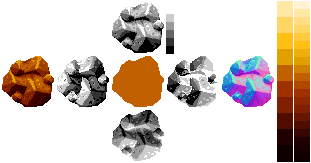For anyone interested, this is how I put the sprite together.

The rock on the far left is the original sprite I drew. To save time you could probably make do without doing this part, but I find it makes it easier to visualize what I'm doing and how I want the final sprite to turn out like.
After that I made my Diffuse sprite, basically just a block of colour.
Then I created my Shadow Maps (no idea what the proper term is for them) to show light coming from the Top, Bottom, Left and Right. I think 4 is really the bare minimum, in other tests I have always done a front facing Sprite as well but this one turned out fine with just the 4.
Then its simply a case of plugging these files into Sprite Lamp and getting it to make you a Normal Map.
The tricky part is then using the Palette Shader to use your own preset colours. Sprite Lamps defult is to set the shading as a gradient from Black to white, and as most people are probably aware, colour theory doesn't work like that.
To start with I used the first colour palette but the results were too blocky and didn't give particulaly good definition to the shape. So I added in more colours and with a bit of trial and error, ended up with the final GIF you see above.
Now I need to go through the whole process again with the other sprites.
Cool, cool, Sprite Lamp looks fantastic. But don't tell me there is no demo to try Sprite Lamp out?
Afraid not. Although its not too expensive and the guy who made it is friendly enough. Which always makes me want to spend money on a product.
 Community
Community DevLogs
DevLogs Kuiper 2
Kuiper 2 Community
Community DevLogs
DevLogs Kuiper 2
Kuiper 2
